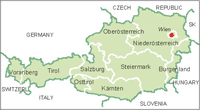
Styria
About Styria
 Styria, in German - Steiermark , is a province (1991 pop. 1,184,593), 6,324 sq mi (16,379 sq km) in central and SE Austria. Graz is the capital. Bordering on Slovenia in the south, Styria is predominately mountainous, with many forests, pastures, and meadowlands. The province is drained by the Mur, Enns, and Raab rivers. It is the chief Austrian mining district (iron ore, lignite, salt, graphite, gypsum, talc, and magnesite) and has a well-developed metals industry, particularly in the north, near the Erzberg. The province also produces paper, cellulose, chemicals, leather, textiles, and food products. Graz is a center of motor-vehicle assembly. Cattle, horses, and poultry are raised, and forestry is an important occupation. There are many Alpine resorts, and tourism is a major source of revenue. ... more
Styria, in German - Steiermark , is a province (1991 pop. 1,184,593), 6,324 sq mi (16,379 sq km) in central and SE Austria. Graz is the capital. Bordering on Slovenia in the south, Styria is predominately mountainous, with many forests, pastures, and meadowlands. The province is drained by the Mur, Enns, and Raab rivers. It is the chief Austrian mining district (iron ore, lignite, salt, graphite, gypsum, talc, and magnesite) and has a well-developed metals industry, particularly in the north, near the Erzberg. The province also produces paper, cellulose, chemicals, leather, textiles, and food products. Graz is a center of motor-vehicle assembly. Cattle, horses, and poultry are raised, and forestry is an important occupation. There are many Alpine resorts, and tourism is a major source of revenue. ... more
Castles & Palaces
 Trautenfels Palace. On foot of the Grimming Mountain there is Trautenfels Palace a castle in baroque style which is used for exhibitions now.
Trautenfels Palace. On foot of the Grimming Mountain there is Trautenfels Palace a castle in baroque style which is used for exhibitions now.
Strechau Castle The castle next to Lassing is one of the largest castles in Styria and dates back to 11th century.
Festenburg Castle. The Castle in the north of the Vorau region was build in the 12th century as a castle and turned into a monastery around the year 1700.
Grubegg Castle. Build in 1591 next to Bad Mitterndorf by a wealthy wood merchant, the mason house offers now a nice boutique hotel. ... more
 Styria, in German - Steiermark , is a province (1991 pop. 1,184,593), 6,324 sq mi (16,379 sq km) in central and SE Austria. Graz is the capital. Bordering on Slovenia in the south, Styria is predominately mountainous, with many forests, pastures, and meadowlands. The province is drained by the Mur, Enns, and Raab rivers. It is the chief Austrian mining district (iron ore, lignite, salt, graphite, gypsum, talc, and magnesite) and has a well-developed metals industry, particularly in the north, near the Erzberg. The province also produces paper, cellulose, chemicals, leather, textiles, and food products. Graz is a center of motor-vehicle assembly. Cattle, horses, and poultry are raised, and forestry is an important occupation. There are many Alpine resorts, and tourism is a major source of revenue. ... more
Styria, in German - Steiermark , is a province (1991 pop. 1,184,593), 6,324 sq mi (16,379 sq km) in central and SE Austria. Graz is the capital. Bordering on Slovenia in the south, Styria is predominately mountainous, with many forests, pastures, and meadowlands. The province is drained by the Mur, Enns, and Raab rivers. It is the chief Austrian mining district (iron ore, lignite, salt, graphite, gypsum, talc, and magnesite) and has a well-developed metals industry, particularly in the north, near the Erzberg. The province also produces paper, cellulose, chemicals, leather, textiles, and food products. Graz is a center of motor-vehicle assembly. Cattle, horses, and poultry are raised, and forestry is an important occupation. There are many Alpine resorts, and tourism is a major source of revenue. ... moreCastles & Palaces
 Trautenfels Palace. On foot of the Grimming Mountain there is Trautenfels Palace a castle in baroque style which is used for exhibitions now.
Trautenfels Palace. On foot of the Grimming Mountain there is Trautenfels Palace a castle in baroque style which is used for exhibitions now.Strechau Castle The castle next to Lassing is one of the largest castles in Styria and dates back to 11th century.
Festenburg Castle. The Castle in the north of the Vorau region was build in the 12th century as a castle and turned into a monastery around the year 1700.
Grubegg Castle. Build in 1591 next to Bad Mitterndorf by a wealthy wood merchant, the mason house offers now a nice boutique hotel. ... more
 Back to top
Back to top


 Romana
Romana English
English











